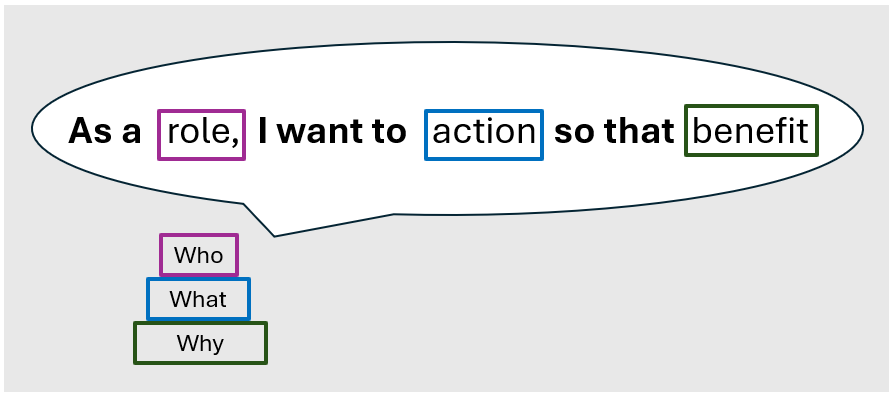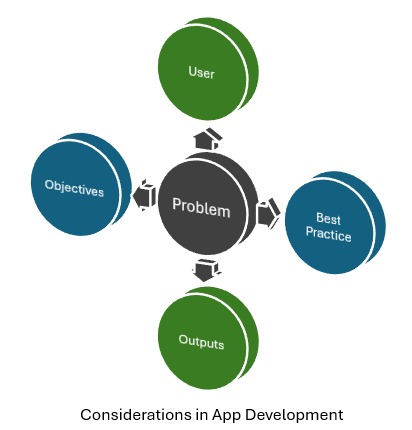Planning

Planning should begin with the end of the process in mind. Outputs (e.g., results) tend to be the drivers for inputs (e.g., choices). Like a good story or movie plot, a decision support app must take a user on a coherent journey through a defined set of inputs and outputs linked by opinionated and validated logic. Story coherence also requires analysis of potential loose-ends or holes in the story line that could jeopardize the user experience.
A good app will define a problem and offer a solution to a well-defined user. Keep in mind problems can be simple, complicated or very complex. To mitigate complexity, setting realistic goals, objectives and outputs for your application keeps the scope of work focused and coherent. Presenting a curated point of view supported by best practice to a well-defined end user builds trust, encourages meaningful knowledge sharing, and supports a culture of continuous improvement.
User Stories Put People First
How you think about the end-goal of your application is an important predictor of quality and the impact the application will have. Applying a few principles and methods from the Agile development framework can help you stay focused.

Building Blocks of a User Story
Agile development teams often communicate through a user story. A user story is an informal, general explanation of an app feature or functionality written from the perspective of the end user. Its purpose is to articulate how the functionality will provide value to the customer (i.e., end user, organization, etc..). Thinking in terms of a user story puts people first, keeps end users at the center of the thought process and reminds the citizen developer why they are building, what they’re building, and what value it creates.
User stories follow this format:
As a (end user), I want (business requirement), so that (value).
Here are a few examples of a user story:
- As a primary care clinician, I want to determine if a patient is at low risk for a pulmonary embolism so that I can decide whether to order a _standard d-dimer _test in the clinic or send the patient directly to the ER for further labs and imaging.
- As a primary care clinician, I want to determine if a patient is unlikely to have a pulmonary embolism so that I can rely on a high sensitivity d-dimer test and take a more conservative approach to determining patient disposition.
Focused on an understanding of the user and their needs, these user stories links the value of testing options to the app functionality, which includes two different risk assessment models: a three-tier model and a two-tier model. Understanding that primary care clinicians may or may not have access to a high sensitivity d-dimer highlights the importance of meaningful and actionable content. Connecting a specific user to a business requirement and its value provides a framework for a coherent user experience.
Core App Development Considerations
A few thoughtful planning exercises can help you curate an effective solution.
Problem & Opportunity Definition
What problem(s) or opportunities are you looking to address?
Clearly define the problem or clinical question and perform a root cause analysis. Consider barriers that block growth and expansion and develop mitigation strategies to ensure your application will make a measurable impact.

Goals & Objectives Identification
What are the objectives and goals?
Setting clearly defined objectives and goals will help you to avoid significant scope creep which diverts attention away from project objectives and can undermine quality.
- Example of an unclear project objective: Improve mental health by addressing top symptoms our patients report.
- Example of a clear project objective: Create at least five different mental health screening apps in Q1 to be performed by primary care clinicians during adult visits involving mental health symptoms, including, depression (PHQ-9), anxiety (GAD-7), alcohol use disorder (AUDIT-C), severity measure for panic disorder and alcohol withdrawal (CIWA-Ar). Closely monitor app engagement in the EVAL patient chart feature on each new app and gather clinician feedback to determine the top three categories and apps to continue honing in future quarters.
Best Practice Incorporation
What sources of evidence or institutional best practices will be used to curate a set of outputs and underpin the user experience?
An app ought to have an opinionated approach. When distilling best practices, consider who the app is targeting (i.e. primary care clinicians versus cardiologists) and include citations so that users can understand the scope or limitations of the curated information and explore practice implications further.
The About tab is an opportunity for the application author to summarize app functionality and rationale as well as provide background and evidence sources for users of the application. There are also multi-media options in the app builder within sections, questions and results that can be used to provide additional guidance to users as they run an application.
Output Identification
What are the outputs of the application?
EVAL's pre-built components include output options (i.e., results section) that can provide information, calculation-based numerical values, multimedia images or videos, or a hybrid of any one of these.
User Analysis
How will the users use the application?
Understanding the user base of your application will allow you to anticipate their needs. Providing custom insights, resources or next steps that are meaningful and actionable can influence adoption. Apps can serve as an education tool, offer decision support, perform calculations, collect data, be used to monitor patient trends, customize protocols or a hybrid of any one of these.
Updated about 1 year ago
